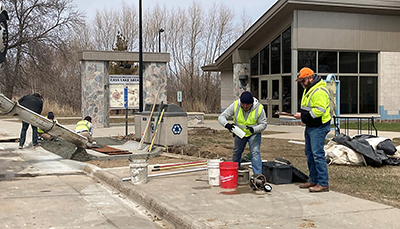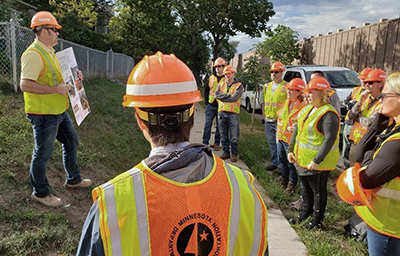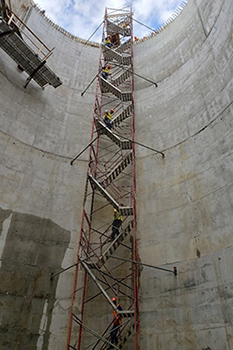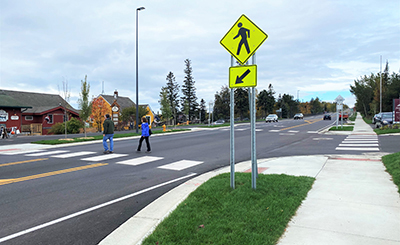 |
|

|
 |
TABLE of CONTENTS
 |
ADA Concrete Construction and Inspection Training Program held on tribal land |

At the Cass Lake Rest Area, MnDOT training participants improve sidewalks to meet standards set by the Americans with Disabilities Act. Rich Haavisto, Advancing Equity, confers with a consultant from Mn Best Inc. Hawk Construction employees are in the background. . Photo by Lee Zutz |
By Su Love, Office of Civil Rights
In May and June, MnDOT delivered a new training series on tribal lands in cement masonry. Participants from Leech Lake Band of Ojibwe, Red Lake Nation and Bois Forte Band of Chippewa learned how to build sidewalks compliant with the Americans with Disabilities Act and inspect them. In the process, they improved tribal land accessibility. It’s noteworthy that all training took place on tribal lands and that training resulted in upgraded tribal infrastructure.
The offices of Civil Rights, Advancing Equity and Tribal Affairs partnered with tribal nations, contractors and cement masons. Together, they provided contracting and training opportunities for both small businesses and tribal members. This is the first time that small business training and workforce training were combined; these are usually held separately.
Coordination with each sovereign tribe was critical in the efforts to tailor the training and plan for success. Tribes selected the location, time, contractor and participants. MnDOT’s ADA program team worked with Native-owned businesses recommended by the tribes and MnDOT consultant PE Services.
“Government to government coordination between the state and tribes is essential to improving employment opportunities for folks across our state. MnDOT is committed to strengthening and developing our relationships with tribal nations on transportation projects and programs, including access to trainings, employment and contracting opportunities,” Commissioner Nancy Daubenberger said.
The three trainings were funded by the Office of Civil Rights and developed with the Office of Advancing Equity. MnDOT team members included Mindy Heinkel, Richard Haavisto, Tracy Olson, Lee Zutz, Adam Marks and Adrien Carretero. District leadership and personnel hosted tours of the Virginia and Bemidji headquarters to promote awareness and foster interest in MnDOT careers.
The training series, in three stages, facilitated relationship-building among tribal government, tribal members, small business consultants and subcontractors, prime contractors, and MnDOT offices. Other MnDOT offices that supported the training include Consultant Services, Purchasing, Minnesota Management and Budget, and Districts 1, 2 and 3.
Advancing Equity used smaller-dollar contracts to hire three small businesses: MN Best, Hawk Construction and Professional Engineering Services. MN Best surveyed, designed and drew up plans, working on tribal lands with tribal partners and MnDOT. Throughout the series, MN Best increased their knowledge, capacity and scopes of work in design, plans, inspection and compliance.
MnDOT and consultants worked with the tribal partners to identify a native-owned small business. In the train-the-trainer part of the series, Hawk Construction, Jim King Construction and Ed Gehlert Construction learned how to construct to MnDOT’s ADA standard specifications for construction. They put that knowledge into action by making sidewalks and pedestrian ramps ADA compliant, meaning the program also improved the accessibility of tribal land. All three contractors earned ADA certification and are now well-placed for future ADA contracting opportunities.
Each tribe recruited up to 16 members per training to participate, with a total attendance of 31 tribal members from Leech Lake, Red Lake, and Boise Forte. Professional Engineering Services and MnDOT staff provided classroom and hands-on training in the field. During these three and half days, trainees learned to construct and inspect to ADA standards and compliance.
“Being able to practice every day what we learned in the morning really helped,” said Tristen Villebrun, who participated in the training with Bois Forte.
Next, trainees toured MnDOT headquarters and additional work areas. Maintenance and construction gave presentations. Trainees learned from Human Resources how to network and apply for jobs. Toward the end of each training, participants were prepared to test for the MnDOT ADA Construction Certificate. To date, trainees have a 100% completion rate.
The program concluded with a graduation ceremony. Representatives from the tribes and MnDOT joined the trainers, consultants, contractors, families, and friends to celebrate the trainees and their accomplishments. Trainees gained experience working with tribal partners, contractors, consultants and MnDOT, and the hope is that this will increase their employment opportunities.
“The program opened up a ton of opportunities for me,” Villebrun said, “and I now have a job in road construction.”
Looking ahead
MnDOT and Lower Sioux Community are currently working together on plans for an ADA hands-on training in Lower Sioux Community in the summer of 2023. For more information, contact Mindy Heinkel or Adam Marks. |
 |
|

|
 |
TABLE of CONTENTS
|
Federal grant to cover cost of six new electric buses for Greater Minnesota transit agencies |
By Joseph Palmersheim

A bus similar to this one with SMART/Cedar Valley Service in Owatonna is one of six to be replaced next year thanks to a $3.4 million federal grant for six electric buses. The new buses will replace six conventional gas-powered buses at four rural transit systems in Greater Minnesota. . Photo by Kirk Kuchera |
Minnesota Department of Transportation recently secured a $3.4 million federal grant for six electric buses. They will replace six conventional gas-powered buses at the following rural transit systems in Greater Minnesota:
- Heartland Express/Brown County Human Services (New Ulm service, two buses)
- SMART/Cedar Valley Services, Inc. (Owatonna service, one bus)
- Prairie Lakes Transit/Faribault-Martin County Transit Board (Fairmont service, one bus)
- Minnesota River Valley Transit (St. Peter and Le Sueur service, two buses)
The funds come from the Bipartisan Infrastructure Law, which provides $5.5 billion over five years for the “Low or No Emission Vehicle Program.”
The six buses being replaced travel approximately 173,300 miles and consume 30,500 gallons of fuel each year.
“Deploying battery electric buses in place of fossil fuel vehicles will reduce energy consumption and harmful emissions, including greenhouse gases and particulates,” said Amber Dallman, MnDOT’s Transit Programs and Implementation assistant director. “Public transit is an important part of our transportation system. Many people in rural areas rely on transit to access jobs, shopping and healthcare. This project helps us make service improvements while working to reduce emissions.”
The grant funding, along with a $425,196 local match from MnDOT, also covers charging equipment, tools, related infrastructure, training and administrative support. Agencies receiving a second bus are responsible for the local match for the second vehicle, at $45,402 apiece.
MnDOT oversees public transit grant programs for Greater Minnesota, including bus replacements. Rural transit systems partnered with MnDOT to submit the application for the competitive funds.
Planning for the projects will start later this year. Infrastructure for the buses should be in place by September 2024, with buses on the road by September 2025. |
 |
|

|
 |
TABLE of CONTENTS
|
All agency employees required to complete IT asset verification begins October 10 |
|
By Joy Graham, Office of Financial Management
All MnDOT employees assigned a computer will need to perform a verification for computers that they use or manage. Asset verification begins on October 10 and must be completed by October 28 and can be completed through the IT Storefront.
The verification process should take no more than 10 minutes per person (depending upon the number of computers assigned to you), including watching a three-minute training video.
If you manage computers located in other buildings or are a supervisor with one or more employees who are on leave (or will be on leave during the verification period,) you are encouraged to complete verification starting October 5.
What do I need to do?
Between October 10 and October 28, you will be asked to use the IT Storefront to view computers that are assigned to you in “managed by” or “used by” status and verify that you are in possession of the computer. If you have a computer that is not on your list of computers, please report the device during the verification.
Detailed instructions are available on the IT Storefront IT Asset Verification page.
Why do I need to verify my computer?
Computers are considered sensitive assets by the Minnesota Department of Administration. Not only are they costly but they can also contain sensitive data. The Department of Administration requires a biennial physical inventory for all sensitive assets. Your participation allows MnDOT to meet this mandatory requirement. To have a successful inventory, MnDOT must achieve 95% or greater accuracy.
This is also a great opportunity to produce cost savings for MnDOT. Use this as an opportunity to see what computers are assigned to you, and if you are still in need of these IT assets. If you have more than one computer assigned to you, please evaluate with your supervisor if this is needed. For every computer assigned, MNDOT is charged $787 per desktop and $1,078 per laptop each year. Additionally, you are responsible for the computer while it is assigned to you. To return a computer to MNIT, contact your district/office workstation coordinator.
Please contact the IT Service Desk for technical support.
For questions about the Computer Verification, please contact: Joy Graham, Finance Centers of Excellence manager, or Susan Walto, business continuity and internal controls manager, Office of Financial Management. |
 |
|

|
 |
TABLE of CONTENTS
|
MnDOT Library provides easy access to ebooks |
By Julie Swiler, Office of Research & Innovation

The cloudLibrary site offers many different options for readers. |
A great selection of books is just a click away with cloudLibrary, a digital lending library available through the MnDOT Library.
All MnDOT employees can access cloudLibrary, all you need is a MnDOT library barcode number, which you can get by contacting the MnDOT Library. (Please note: This number is NOT your state employee ID.)
You can read cloudLibrary books on your computer or mobile device. The range of subjects in the MnDOT collection includes professional development, diversity and inclusion, innovation, transportation, public policy and more.
To access MnDOT’s ebook collection from your phone, computer or other devices, use the following steps:
- Download the cloudLibrary app from the Apple App Store (iPhone and iPads), Google Play Store (Android devices) or cloudLibrary website (all compatible devices).
- Select Minnesota as your state.
- Select MnDOT from the dropdown list of libraries.
- Log in with your MnDOT barcode number. No password is required.
- Start browsing the titles!
The website also provides the option to read ebooks directly from your browser, no download needed.
Visually impaired users can read ebooks with a browser using the JAWS screen reader. The text of the books can also be made dyslexia-friendly when using the apps.
Interested in a title we don’t currently carry? You are welcome to suggest titles for the library to consider.
For more details or assistance, contact the MnDOT Library. |
 |
|

|
 |
TABLE of CONTENTS
|
On the Job: Nancy Boeve manages bidding, contracting for highway construction |
|
By Joseph Palmersheim
Nancy Boeve is MnDOT’s contracts and letting supervisor. She’s been with the agency for 25 years, with the last 16 of those years in her current position at the Office of Construction and Innovative Contracting.
What do you do in your role and where are you based?
I am based in Central Office. Simply put, I manage the bidding and contracting for highway construction. My job is very customer focused. I’m an advisor, teacher, mentor, enforcer and MnDOT ambassador. I routinely help contractors, districts, specialty offices, local governments, FHWA and the general public.
How would you describe letting, and why is it important to what MnDOT does?
“Letting” means the date and time bids are due and will be opened. Think of it as, “Let the games begin!” It is integral to Program Delivery. Letting is where everything and everyone comes together: preconstruction, contractors and construction. Letting is the pivotal piece between them all.
The letting schedule is very fast paced. Everything we do in my unit has a timer attached to it. I often refer to it as “spinning plates.” Think of each proposal (potential contract) in a letting as a plate. We need to ensure all plates keep spinning so none drop and projects stay on schedule. After bids are opened, we have 33 days to make a contract award (offer the contract). Each contract has multiple clearances that must be met prior to the award. Multiple specialty offices are involved in the different types of clearances. Clearances are additional plates lined up behind the original.
Every proposal goes through bid analysis for material and mathematical balance. The majority will have some sort of subcontracting goal (such as Disadvantaged Business Enterprise, Targeted Group Business or Veteran-owned business), and many may have one or more outstanding permits or agreements, all of which need to clear in order for us to make award. Once award is made, a new timer starts for contract approval (fully executed contract). We regularly have multiple lettings in play at the same time, so there is never a dull moment.
What do you enjoy most about your job?
I love helping people. I also love the adrenaline of a bid letting morning. It is live theater—anything can happen. Sometimes it is quiet and there are no phone calls from contractors, which is a good thing generally. But it’s also very gratifying and exhilarating to help a new bidder in crisis during crunch time. Oftentimes, they just need a calm and reassuring voice to help them be successful when submitting an electronic bid for the first time.
What did you want to be when you were growing up, and how did you come to be at MnDOT?
As a kid, I thought I would be a teacher or a performer. In my position, I get to do a bit of each, so it plays to my strengths and passions. I have high job satisfaction. I came to MnDOT in 1997 on a temporary assignment. I never dreamed I would be here 25 years later. But it just goes to show you that life is full of surprises. Sometimes the path you find yourself on, though unexpected, is right where you are meant to be.
Do you or a co-worker have an interesting job to share with readers? Send us your ideas, and we’ll contact you for more information.
Recent employee profiles:
|
 |
|

|
 |
TABLE of CONTENTS
|
Mentor and sponsor program open for applications |
|
By Frida Alvarez, diversity and inclusion organizational development specialist MnDOT’s mentor and sponsor program is returning in 2023, and applications are now open.
The programs helps employees thrive in the workplace by connecting employees with more experienced peers to receive guidance and feedback, identify strengths and opportunities, plan professional goals, build a network and just chat. The programs begin in January and last one year.
Mentoring is led by the mentee and is based on the mentee’s goals and interests. It is an opportunity to learn about themselves, the direction they want to go and build self-esteem and leadership skills.
Sponsorship is led by the sponsor. The goal is to guide the mentee in reaching their full potential through stretch assignments and other program activities, or through workplace accomplishments and growth that leads the mentee to apply for a job promotion, lateral move, or apply to become a Peer Equity and Inclusion Coach and support other DEI initiatives at MnDOT.
All matches start as mentorships. The mentor can request the mentorship turn into a sponsorship, in the second year of the program, if they think the mentee is ready and if the mentee has met the program requirements.
“My mentor, Ann, has supported me by providing feedback on situations, motivating me to step out of my comfort zone in my path and provided impartial guidance,” said Barbara Schreiber, a real estate representative in Transit Operations.
Schreiber’s mentor, Ann McLellan, said it was a positive experience for her, too. “It was great sharing experiences with each other and sharing what I know about MnDOT to guide her. During our conversations, we realized we had a lot of similarities, including working in project management and attending the same college, , which enabled us to understand and help each other even more.”
Two upcoming sessions, both conducted virtually via Teams, will provide more information for anyone interested in participating in the programs, either as a sponsor/mentor or a mentee. (Both sessions will include the same information.)
Thursday, October 20, 12:00 p.m. – 1:00 p.m. (Teams link)
Thursday, November 10, 7:30 a.m. – 8:30 a.m. (Teams link)
To apply for the mentor and sponsor program, please complete this online application. If you have any questions, please contact Frida Alvarez, diversity and inclusion organizational development specialist.
Frequently Asked Questions
Who can participate in this program?
- Any MnDOT employee can participate in this program, provided they meet all eligibility requirements. This will be a competitive process where potential participants must submit an application.
How do I apply?
How often do we meet?
- Each pair is required to meet at least twice per month, either virtually or in person.
How long are the meetings?
- Meetings should be at least 30 minutes.
Should we have the same home office, or can we be at different locations?
- You can be from different locations—in fact, it’s often better if you are not in the same home office. But there is no requirement either way.
Can I be both a mentor and mentee?
- Yes, you can participate as both.
How is the match made?
- During recruitment, there will be a profile for mentors and mentees to fill out. Once the recruitment timeframe is closed, the D&I Org Development Specialist will review the profiles and match them based on answers. Mentorships will be announced at the orientation in January.
Who schedules the meetings?
- The first meeting will be the orientation you both will attend. After that, it’s up to each pair, based on what you have agreed to per contract.
What if I’d like to be re-matched?
- Contact the D&I Org Development Specialist to discuss the situation(s).
- After discussing the situation and a re-match is needed, then the re-match process begins.
- The D&I Org Development Specialist will review the applications received and rematch.
Do I have to wait until the end of the term if I would like a re-match?
- That will depend on the availability of mentors/mentees.
What do I do if I want or need to take a break?
|
 |
|

|
 |
TABLE of CONTENTS
|
Leadership Development Program tours I-35W Stormwater Storage Facility site |
By Elizabeth Otto, Office of Workforce Development

LDP participants learned about the construction process from the project manager, Tim Nelson, P.E., Resident Engineer, MnDOT Golden Valley Central Construction Office, before walking through the 35W Stormwater Storage Facility project site. . Photo by Elizabeth Otto |
On September 21, a group of 26 Leadership Development Program participants visited the I-35W Stormwater Storage Facility project site to learn more about MnDOT’s ability to adapt in response to the needs of the times.
The I-35W stormwater tunnel system was constructed in the 1960s to carry stormwater runoff from the highway and the surrounding neighborhoods, but development in the surface draining area and changing weather patterns since then mean that the system is no longer able to handle stormwater during large storm events.

LDP participants descend scaffolding stairs 80 feet into a storage tank at the 35W Stormwater Storage Facility site. Seeing the underground parts of this structure is a once-in-a-lifetime opportunity because, when this project is completed in 2023, people will no longer be able to descend into the tank without the risk of flooding or the need for supplemental lighting. . Photo by Elizabeth Otto |
To help reduce flooding on I-35W at 42nd and 46th Streets, MnDOT is employing the Construction Manager General Contractor project delivery process to partner with contractors to design and build the
Stormwater Storage Facility in coordination with the major MnDOT project in the area. This is a first-of-its-kind structure for stormwater storage in Minnesota and will hold more than 4.5 million gallons of water.
Organizational knowledge learning opportunities like this one are open only to Leadership Development Program participants and alumni. These active learning experiences allow LDP participants to develop a deeper understanding of the work of the agency.
In an anonymous evaluation of this I-35W Stormwater Storage Facility training, one participant commented, “I cannot express enough how awesome this experience was. It was very cool to see not just the structure but the variety of people interested in its construction. Experiences like this are irreplaceable tools for understanding the true scope of what MnDOT does.”
The next open enrollment period of the Leadership Development Program will be from December 12, 2022, to January 13, 2023. Employees who enroll at that time will join Group 20, which will start on March 1, 2023.
The Leadership Development Program is designed to be flexible and tailored to individuals so that it can benefit any MnDOT employee. To learn more about the Leadership Development Program, please visit the LDP iHUB page. |
 |
|

|
 |
TABLE of CONTENTS
|
Reminder: Vote for the Hwy 61 project in America’s Transportation Awards |
By Pippi Mayfield (District 1) and Doug Mack

Pedestrians cross Hwy 61 at a new crosswalk in Grand Marais. Photo from District 1 staff
|
As mentioned in the last issue of Newsline, MnDOT’s Hwy 61 project, in District 1, is one of 12 finalists for America’s Transportation Awards. The annual competition, sponsored by AASHTO, AAA and the U.S. Chamber of Commerce, has both a Grand Prize, selected by a jury of transportation industry experts, and a People’s Choice Award, determined by a public vote via the awards program website. Members of the public—including MnDOT employees!—can vote up to one time per day through October 21.
Both awards come with a $10,000 cash prize to be donated to a charity or scholarship of the winning DOT's choosing. If the Hwy 61 project wins, MnDOT plans to use the funds for the Roberta Dwyer Scholarship Fund. Roberta was a well-known project manager in D1 for more than 30 years and worked on many projects, including the Twin Ports Interchange project. The scholarship in her name is for women interested in entering the engineering field.
AASHTO will announce the winners at its annual meeting in Orlando later this month.
The Hwy 61 project focused on improving pedestrian mobility and safety along the North Shore of Lake Superior. This work, which totaled $19.2 million, included narrowing the roadway, building better biking and pedestrian facilities along each side of the roadway and creating an environment where highway traffic would slow down so crossing the roadway would be safer. It also involved innovative land use, creating an attractive roadside environment that includes places to gather and rest, improved green space, and new lighting that improved visibility and safety for pedestrians and bikers while preserving the dark sky environment of the North Shore. |
 |
|
| |
|



